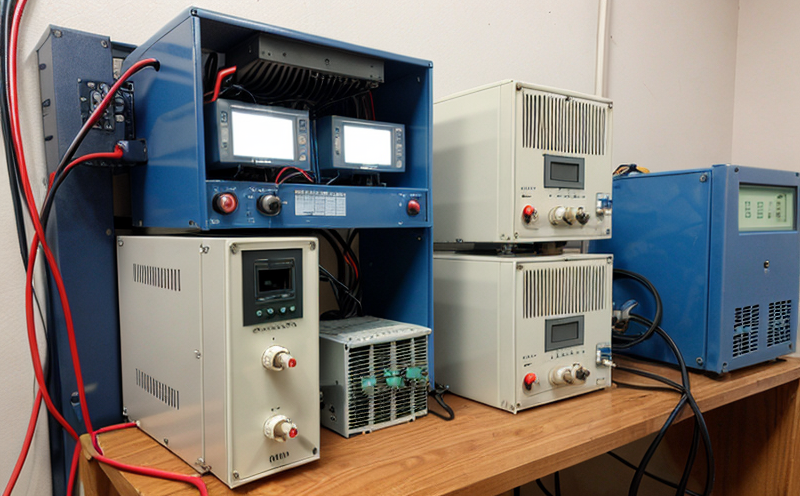IEC 61377 Traction Converter Performance Testing
The IEC 61377 standard is a key document for the electrical and power supply systems of railway traction converters. It provides a comprehensive framework to ensure that the traction converters in railway vehicles meet stringent performance, safety, and reliability requirements. This service focuses on the detailed testing procedures outlined in this standard, ensuring that manufacturers adhere to international standards and deliver safe and reliable traction converters.
The IEC 61377-2-4 standard specifically addresses the electrical tests for power converters used in railway applications. These converters play a critical role in converting the voltage from the overhead lines into the required levels for propulsion and auxiliary systems within trains. The testing procedure covers various aspects such as thermal cycling, insulation resistance measurement, dielectric strength test, transient response, and harmonic analysis.
Thermal cycling tests are essential to evaluate the converter's ability to withstand temperature variations during operation. This is crucial given the varying environmental conditions encountered in railway operations. Insulation resistance testing ensures that there are no unwanted current paths within the system, which could lead to short circuits or other failures. The dielectric strength test assesses the converter’s capability to handle high voltages without breakdown, ensuring safe and efficient operation.
The transient response tests check how quickly and accurately the converter can adjust its output voltage in response to changes in load conditions. This is particularly important for railway applications where the load can vary significantly depending on the number of passengers or the current terrain. Harmonic analysis ensures that the converted power has minimal distortion, which helps in maintaining the integrity of other electrical systems within the train.
The testing process involves preparing the traction converter by connecting it to a specialized test rig that simulates real-world operating conditions. The specimen preparation includes ensuring all connections are secure and clean before the tests begin. Once connected, the converter undergoes a series of tests that follow the procedures detailed in IEC 61377-2-4.
The results of these tests provide critical data on the performance characteristics of the traction converter. This information is essential for quality managers to ensure compliance with international standards and for R&D engineers to refine their designs. Compliance officers can use this data to verify that suppliers meet the necessary regulatory requirements, while procurement teams can select suppliers based on demonstrated reliability.
By adhering to these stringent tests, railway manufacturers can ensure a high level of safety and reliability in their products, which is critical for public transport systems. This service helps to bridge the gap between theoretical standards and practical application, providing a robust framework for quality assurance.
| Applied Standards |
|---|
| IEC 61377-2-4 |
Why Choose This Test
The IEC 61377 Traction Converter Performance Testing is crucial for several reasons. Firstly, it ensures that the traction converters meet international safety and reliability standards, which is essential for railway operations where safety is paramount. Secondly, by adhering to this testing procedure, manufacturers can demonstrate compliance with regulatory requirements, which is vital for market access in various countries.
The tests also provide valuable data on the performance characteristics of the converter, which can be used to improve product designs and enhance reliability. This information is particularly useful for R&D engineers who are continually looking to optimize their products. For quality managers, this testing service offers a way to ensure that all components meet the required standards, thereby minimizing the risk of defects reaching the final product.
Compliance officers can use the results from these tests to verify supplier performance and ensure that they are meeting regulatory requirements. This is especially important in the railway sector where safety is a key concern. For procurement teams, selecting suppliers based on their test results ensures that only reliable and compliant products are chosen.
The testing process is designed to be rigorous and comprehensive, ensuring that every aspect of the traction converter’s performance is evaluated. This level of scrutiny helps to identify any potential weaknesses or areas for improvement, which can ultimately lead to safer and more efficient railway systems.
International Acceptance and Recognition
- The IEC 61377 standard is widely recognized in the global railway industry.
- Major railway manufacturers around the world use this standard for their testing procedures.
- Many countries, including those with stringent safety regulations, have adopted this standard as a mandatory requirement for traction converters.
- The results from these tests are accepted across various international standards bodies and regulatory authorities.
The widespread acceptance of the IEC 61377 standard ensures that manufacturers can confidently export their products to different markets. This is particularly important in the railway sector, where compliance with international standards is a key factor for market access. The recognition by major industry players and regulators further enhances the credibility of the test results.
The testing process itself is designed to be transparent and reproducible, ensuring that the results are consistent across different laboratories worldwide. This consistency is crucial in an industry as regulated as railway traction systems, where safety and reliability are non-negotiable.





